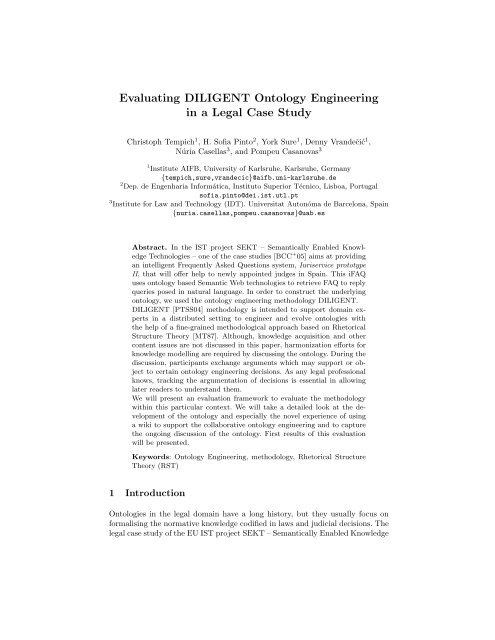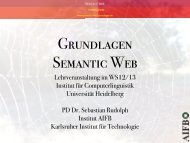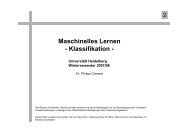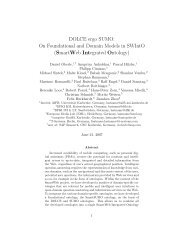Evaluating DILIGENT Ontology Engineering in a Legal Case Study
Evaluating DILIGENT Ontology Engineering in a Legal Case Study
Evaluating DILIGENT Ontology Engineering in a Legal Case Study
Create successful ePaper yourself
Turn your PDF publications into a flip-book with our unique Google optimized e-Paper software.
<strong>Evaluat<strong>in</strong>g</strong> <strong>DILIGENT</strong> <strong>Ontology</strong> <strong>Eng<strong>in</strong>eer<strong>in</strong>g</strong><br />
<strong>in</strong> a <strong>Legal</strong> <strong>Case</strong> <strong>Study</strong><br />
Christoph Tempich 1 , H. Sofia P<strong>in</strong>to 2 , York Sure 1 , Denny Vrandečić 1 ,<br />
Núria <strong>Case</strong>llas 3 , and Pompeu Casanovas 3<br />
1 Institute AIFB, University of Karlsruhe, Karlsruhe, Germany<br />
{tempich,sure,vrandecic}@aifb.uni-karlsruhe.de<br />
2 Dep. de Engenharia Informática, Instituto Superior Técnico, Lisboa, Portugal<br />
sofia.p<strong>in</strong>to@dei.ist.utl.pt<br />
3 Institute for Law and Technology (IDT). Universitat Autonóma de Barcelona, Spa<strong>in</strong><br />
{nuria.casellas,pompeu.casanovas}@uab.es<br />
Abstract. In the IST project SEKT – Semantically Enabled Knowledge<br />
Technologies – one of the case studies [BCC + 05] aims at provid<strong>in</strong>g<br />
an <strong>in</strong>telligent Frequently Asked Questions system, Iuriservice prototype<br />
II, that will offer help to newly appo<strong>in</strong>ted judges <strong>in</strong> Spa<strong>in</strong>. This iFAQ<br />
uses ontology based Semantic Web technologies to retrieve FAQ to reply<br />
queries posed <strong>in</strong> natural language. In order to construct the underly<strong>in</strong>g<br />
ontology, we used the ontology eng<strong>in</strong>eer<strong>in</strong>g methodology <strong>DILIGENT</strong>.<br />
<strong>DILIGENT</strong> [PTSS04] methodology is <strong>in</strong>tended to support doma<strong>in</strong> experts<br />
<strong>in</strong> a distributed sett<strong>in</strong>g to eng<strong>in</strong>eer and evolve ontologies with<br />
the help of a f<strong>in</strong>e-gra<strong>in</strong>ed methodological approach based on Rhetorical<br />
Structure Theory [MT87]. Although, knowledge acquisition and other<br />
content issues are not discussed <strong>in</strong> this paper, harmonization efforts for<br />
knowledge modell<strong>in</strong>g are required by discuss<strong>in</strong>g the ontology. Dur<strong>in</strong>g the<br />
discussion, participants exchange arguments which may support or object<br />
to certa<strong>in</strong> ontology eng<strong>in</strong>eer<strong>in</strong>g decisions. As any legal professional<br />
knows, track<strong>in</strong>g the argumentation of decisions is essential <strong>in</strong> allow<strong>in</strong>g<br />
later readers to understand them.<br />
We will present an evaluation framework to evaluate the methodology<br />
with<strong>in</strong> this particular context. We will take a detailed look at the development<br />
of the ontology and especially the novel experience of us<strong>in</strong>g<br />
a wiki to support the collaborative ontology eng<strong>in</strong>eer<strong>in</strong>g and to capture<br />
the ongo<strong>in</strong>g discussion of the ontology. First results of this evaluation<br />
will be presented.<br />
Keywords: <strong>Ontology</strong> <strong>Eng<strong>in</strong>eer<strong>in</strong>g</strong>, methodology, Rhetorical Structure<br />
Theory (RST)<br />
1 Introduction<br />
Ontologies <strong>in</strong> the legal doma<strong>in</strong> have a long history, but they usually focus on<br />
formalis<strong>in</strong>g the normative knowledge codified <strong>in</strong> laws and judicial decisions. The<br />
legal case study of the EU IST project SEKT – Semantically Enabled Knowledge
Technologies – differs from that radically, as it tries not to model the normative<br />
knowledge but rather the much more diverse knowledge of legal professionals,<br />
especially judges, <strong>in</strong> their daily work. We will beg<strong>in</strong> with a brief description of<br />
the SEKT legal case study <strong>in</strong> section 2.<br />
Next we describe the <strong>in</strong>itial processes used <strong>in</strong> develop<strong>in</strong>g the ontology, and<br />
the problems encountered, <strong>in</strong> section 3. The ontology eng<strong>in</strong>eer<strong>in</strong>g team focused<br />
on the competency questions used for build<strong>in</strong>g the ontology. We describe how<br />
they were applied, followed by the <strong>in</strong>troduction of the <strong>DILIGENT</strong> argumentation<br />
framework and the track<strong>in</strong>g of arguments <strong>in</strong> section 4. These changes <strong>in</strong>troduce<br />
parts of the <strong>DILIGENT</strong> ontology eng<strong>in</strong>eer<strong>in</strong>g processes, which is described <strong>in</strong><br />
much more detail <strong>in</strong> [PTSS04].<br />
Although <strong>DILIGENT</strong> was already evaluated <strong>in</strong> different sett<strong>in</strong>gs (refer, for<br />
example, to [PSST04] for a case study), the legal case study offers a new and fertile<br />
sett<strong>in</strong>g for further evaluation, due to its sett<strong>in</strong>g <strong>in</strong> the legal doma<strong>in</strong>, which is<br />
novel for the developers of <strong>DILIGENT</strong>. In section 5 we will evaluate the changes<br />
<strong>in</strong>troduced to the ontology eng<strong>in</strong>eer<strong>in</strong>g processes, and highlight the positive implications<br />
and the deficiencies of the processes applied. Based on this, we give<br />
a short outlook to the further development of the methodology and the tools<br />
support<strong>in</strong>g it <strong>in</strong> the last section.<br />
2 The Iuriservice II scenario<br />
The goal of the legal case study is to provide support to professional judges.<br />
In the Spanish system one particular problem young judges face is when they<br />
are on duty and confronted with situations <strong>in</strong> which they are not sure what to<br />
do. In such cases, they usually phone their former tra<strong>in</strong><strong>in</strong>g tutor (experienced<br />
judges) for resolv<strong>in</strong>g the issue. But this is a slow and <strong>in</strong>secure procedure. In this<br />
case study, it is planned to develop an <strong>in</strong>telligent system to speed up the process<br />
and to relieve experienced judges from this effort by provid<strong>in</strong>g support to young<br />
judges. Only <strong>in</strong> the case that the requested knowledge is not <strong>in</strong> the system and<br />
cannot be reformulated from already stored knowledge, an experienced judge<br />
will be contacted. The result of this “expensive” consultation will be fed back<br />
<strong>in</strong>to the system automatically.<br />
In order to build a scalable and useful system, several requirements have<br />
been identified [RCCP04]. In particular, the decision as to whether a request for<br />
knowledge is covered by the knowledge stored <strong>in</strong> the system should be based on<br />
semantics of the legal doma<strong>in</strong> rather than on simple word match<strong>in</strong>g. An ontology<br />
can be used to perform this semantic match<strong>in</strong>g. <strong>Case</strong>-based reason<strong>in</strong>g techniques<br />
will be used when considered applicable. The ma<strong>in</strong> difference with traditional<br />
CBR approaches is that we will use a semantic-based similarity measures based<br />
on ontologies. Moreover, cases will be - where possible - automatically extracted<br />
from <strong>in</strong>formation generated by judges as they perform their daily work.<br />
The ontology used for this semantic match<strong>in</strong>g, the OPJK (<strong>Ontology</strong> for<br />
Professional Judicial Knowledge) [BCC + 05], is be<strong>in</strong>g developed <strong>in</strong> the SEKT<br />
project. For further <strong>in</strong>formation on the OPJK refer to [CCP + 05], here we will
present the problems that have arisen dur<strong>in</strong>g the development of the ontology<br />
and how different approaches towards solv<strong>in</strong>g these problems have worked out.<br />
3 The <strong>in</strong>itial processes<br />
In order to build the ontology, the UAB legal experts team first collected and<br />
consolidated a list of over 800 competency questions that were expected to be<br />
answered by the Iuriservice II prototype. These questions were collected <strong>in</strong> a<br />
strenuous and lengthy process. In order to process the vast number of competency<br />
questions, they were first clustered <strong>in</strong> different groups, so that the ontology<br />
eng<strong>in</strong>eer<strong>in</strong>g process could be steered by the themes identified <strong>in</strong> the questions.<br />
Us<strong>in</strong>g the competency questions, the relevant terms and relations <strong>in</strong> the<br />
questions were identified. The team then discussed the need to represent them<br />
with<strong>in</strong> the ontology and their place with<strong>in</strong> the taxonomy. And accord<strong>in</strong>gly, we<br />
followed the middle-out strategy [GPFLC03]. With this strategy, the core of<br />
basic terms are identified first and then they are specified and generalized if<br />
necessary. F<strong>in</strong>ally, the relevant relations between those terms also have to be<br />
identified (ma<strong>in</strong>ly is a and <strong>in</strong>stance of ). Furthermore, some other relations were<br />
also identified: someone creates a document, thus there is a relation has author.<br />
One of the ma<strong>in</strong> h<strong>in</strong>drances when build<strong>in</strong>g the ontology was the wish to represent<br />
the answers with<strong>in</strong> the ontology. Only by a closer analysis of the planned<br />
usage of the ontology with<strong>in</strong> the Iuriservice II system it was realised that the<br />
ontology will not be used to answer the question but rather to allow for a semantic<br />
match<strong>in</strong>g of the naturally poised questions. Thus, <strong>in</strong>stead of modell<strong>in</strong>g<br />
the answers with<strong>in</strong> the ontology, modell<strong>in</strong>g the questions was enough. This reduced<br />
the complexity of the ontology drastically and especially allowed for a<br />
well-def<strong>in</strong>ed limit <strong>in</strong>side the discussions.<br />
However, difficulties <strong>in</strong> reach<strong>in</strong>g consensual decisions and the lack of traceable<br />
l<strong>in</strong>es of argumentation was slow<strong>in</strong>g down the construction of the ontology. For<br />
that reason, the <strong>in</strong>troduction of the Distributed, Loosely-controlled and evolv<strong>in</strong>g<br />
<strong>Eng<strong>in</strong>eer<strong>in</strong>g</strong> of oNTologies (<strong>DILIGENT</strong>), provided by the AIFB research team,<br />
offered a reliable basis for a controlled discussion of the arguments <strong>in</strong> favour and<br />
aga<strong>in</strong>st modell<strong>in</strong>g decision. The <strong>in</strong>troduction of <strong>DILIGENT</strong> proved the need to<br />
rely on guidel<strong>in</strong>es for the decision-mak<strong>in</strong>g process with<strong>in</strong> ontology design.<br />
4 <strong>DILIGENT</strong> Argumentation Framework and track<strong>in</strong>g<br />
There is evidence that distributed ontology development can be rather time<br />
consum<strong>in</strong>g, complex and difficult, <strong>in</strong> particular gett<strong>in</strong>g agreement among doma<strong>in</strong><br />
experts. Therefore, one needs an appropriate framework to assure it <strong>in</strong> a<br />
speedier and easier way. In order to provide better support, one needs to identify<br />
which k<strong>in</strong>d of arguments are more relevant and effective to reach consensus. The<br />
Rhetorical Structure Theory (RST, see [MT87]) can be used to classify the k<strong>in</strong>ds<br />
of arguments most often used and identify the most effective ones. The ontology<br />
eng<strong>in</strong>eer<strong>in</strong>g methodology <strong>DILIGENT</strong> [PTSS04] is <strong>in</strong>tended to support doma<strong>in</strong>
experts <strong>in</strong> a distributed sett<strong>in</strong>g to eng<strong>in</strong>eer and evolve ontologies with the help<br />
of a f<strong>in</strong>e-gra<strong>in</strong>ed methodological approach based on RST.<br />
With the help of RST and case studies we identified the the most effective<br />
arguments and created an argumentation ontology described <strong>in</strong> [TPSS05]. The<br />
discussions that came up when build<strong>in</strong>g the ontology were focussed by allow<strong>in</strong>g<br />
to concentrate only on the given set of arguments, and thus shortened much.<br />
The arguments exchanged dur<strong>in</strong>g the discussion can also serve as a rationale<br />
about the ontology eng<strong>in</strong>eer<strong>in</strong>g decisions. Track<strong>in</strong>g these arguments solves many<br />
of the problems described <strong>in</strong> the previous section: the tracked arguments allow<br />
anyone to return to the discussion and understand the reasons for a certa<strong>in</strong> decision,<br />
both for the new user who entered the eng<strong>in</strong>eer<strong>in</strong>g team later as well as<br />
the users who were there at the decision itself, but can not remember the rationale<br />
beh<strong>in</strong>d it. As any legal professional will agree, track<strong>in</strong>g the argumentation<br />
beh<strong>in</strong>d decisions is essential <strong>in</strong> order to susta<strong>in</strong> a consistent system.<br />
We offered an easily accessible web based <strong>in</strong>terface <strong>in</strong> order to allow the<br />
discussion <strong>in</strong> a traceable way. A standard wiki was used which supports seamless<br />
discussion and offers ease of use. But the users quickly extended it <strong>in</strong> comb<strong>in</strong>ation<br />
with the KAON OIModeller [GSV04]: they modelled the ontologies agreed on,<br />
made a snapshot of part of ontology and imported it to the wiki, <strong>in</strong> order to<br />
visualize the ontology and ease the discussion and understand<strong>in</strong>g of it. In figure<br />
1 we see a screenshot of the wiki, runn<strong>in</strong>g on the SEKT portal, show<strong>in</strong>g the<br />
concept Hecho with its description, argumentation and attributes, as well as a<br />
graph made with the KAON OIModeller show<strong>in</strong>g the concept and its attributes.<br />
5 Evaluation of the processes<br />
In the case study two ontology eng<strong>in</strong>eer<strong>in</strong>g processes were used. The <strong>in</strong>itial one<br />
was used for about five months and <strong>in</strong>cluded a lot of discussions, but f<strong>in</strong>ally all<br />
results were abandoned. The second process, follow<strong>in</strong>g <strong>DILIGENT</strong>, was started<br />
afterwards. In only a few weeks time the UAB legal experts team managed to<br />
pass through 200 of the competency questions and to agree on an ontology with<br />
50 concepts, 100 relations and over 300 <strong>in</strong>stances (follow<strong>in</strong>g the explicit goal to<br />
keep the number of concepts small).<br />
Geographically distributed members of the team were f<strong>in</strong>ally able to follow<br />
the discussions, due to the capture of the argumentation on the web-accessible<br />
wiki. Also new members could refer to wiki <strong>in</strong> order to understand the rationale<br />
of certa<strong>in</strong> modell<strong>in</strong>g decisions. Before the <strong>in</strong>troduction of the wiki this was not<br />
possible: the only possibility to get these <strong>in</strong>formations was by ask<strong>in</strong>g the members<br />
of the team that were <strong>in</strong>volved <strong>in</strong> the discussion, and hop<strong>in</strong>g that they remember.<br />
Us<strong>in</strong>g thematically clustered competency questions <strong>in</strong>stead of proccess<strong>in</strong>g<br />
them <strong>in</strong> an unordered way brought a noticeable speed up: there was no need to<br />
keep chang<strong>in</strong>g the context from question to question. The discussion was more<br />
efficient by keep<strong>in</strong>g the cognitive distance of one question to the next small.<br />
As there are no protocols of the discussions dur<strong>in</strong>g the <strong>in</strong>itial ontology eng<strong>in</strong>eer<strong>in</strong>g<br />
process, we cannot compare the effect of the <strong>in</strong>troduction of the RST
Fig. 1. Screenshot of the wiki used for discuss<strong>in</strong>g the legal ontology<br />
based <strong>DILIGENT</strong> Argumentation Framework. Although the members of the<br />
UAB legal experts team claim a higher efficiency <strong>in</strong> their discussions, this can<br />
also stem from other sources (like hav<strong>in</strong>g the former discussion available, or<br />
build<strong>in</strong>g on an already agreed-on foundation of a few concepts). We have to rely<br />
on former case studies (like [PSST04]) for this question.<br />
6 Conclusion<br />
As we have seen <strong>in</strong> the previous section, we ga<strong>in</strong>ed quite some efficiency by<br />
apply<strong>in</strong>g <strong>DILIGENT</strong>. <strong>DILIGENT</strong> improves the ontology eng<strong>in</strong>eer<strong>in</strong>g process,<br />
by follow<strong>in</strong>g a pr<strong>in</strong>ciple that is accepted for a long time <strong>in</strong> the legal doma<strong>in</strong>:<br />
traceability of argumentations. But we also found some deficiencies with apply<strong>in</strong>g<br />
our methodology that we have to <strong>in</strong>vestigate further.<br />
For the track<strong>in</strong>g of the ontology we used an off the shelf standard wiki. But<br />
the UAB legal experts team demands graphical, <strong>in</strong>tuitive and easy accessible<br />
user <strong>in</strong>terfaces. They want tools that help them with the specific tasks they<br />
encounter when deal<strong>in</strong>g with ontology eng<strong>in</strong>eer<strong>in</strong>g. They have gone great lengths<br />
to comb<strong>in</strong>e the graphical ability of the KAON OI modeller with the flexibility<br />
and easy accessibility of the web based wiki software.<br />
So the given tool support as it is now is not optimal. A standard wiki can<br />
only be one build<strong>in</strong>g block of a <strong>DILIGENT</strong> <strong>in</strong>spired ontology eng<strong>in</strong>eer<strong>in</strong>g tool.
The users <strong>in</strong> the given case study were highly motivated and expanded the usage<br />
of the tool creatively <strong>in</strong> order to achieve what they wanted, but we cannot expect<br />
this from all users.<br />
Nevertheless, the evaluation of <strong>DILIGENT</strong> was very positive. We achieved<br />
big ga<strong>in</strong>s <strong>in</strong> terms of speed of development and documentation of the results. We<br />
will cont<strong>in</strong>ue to <strong>in</strong>vestigate <strong>in</strong> the above mentioned issues <strong>in</strong> order to enhance<br />
<strong>DILIGENT</strong>and the tools associated with the methodology.<br />
Acknowledgements. Research reported <strong>in</strong> this paper has been f<strong>in</strong>anced by EU <strong>in</strong><br />
the the IST project SEKT (IST-2003-506826).<br />
References<br />
[BCC + 05] V.R. Benjam<strong>in</strong>s, P. Casanovas, J. Contreras, J.M. Lopez Cobo, and<br />
L. Lemus. Iuriservice: An <strong>in</strong>telligent frequently asked questions system<br />
to assist newly appo<strong>in</strong>ted judges. In V.R. Benjam<strong>in</strong>s, P. Casanovas,<br />
A. Gangemi, and B. Selic, editors, Law and the Semantic Web, LNCS,<br />
Berl<strong>in</strong> Heidelberg, 2005. Spr<strong>in</strong>ger.<br />
[CCP + 05] P. Casanovas, N. <strong>Case</strong>llas, M. Poblet, J. Vallbé, Y. Sure, and D. Vrandečić.<br />
Iuriservice ii ontology development. In Workshop on Artificial Intelligence<br />
and Law at the XXIII. World Conference of Philosophy of Law and Social<br />
Philosophy, 2005.<br />
[GPFLC03] A. Gómez-Pérez, M. Fernández-López, and O. Corcho. Ontological <strong>Eng<strong>in</strong>eer<strong>in</strong>g</strong>.<br />
Advanced Information and Knowlege Process<strong>in</strong>g. Spr<strong>in</strong>ger, 2003.<br />
[GSV04] T. Gabel, Y. Sure, and J. Voelker. KAON – ontology management <strong>in</strong>frastructure.<br />
SEKT <strong>in</strong>formal deliverable 3.1.1.a, Institute AIFB, University of<br />
Karlsruhe, 2004.<br />
[MT87] William C. Mann and Sandra A. Thompson. Rhetorical structure theory:<br />
A theory of text organization. In Livia Polanyi, editor, The Structure of<br />
Discourse. Ablex Publish<strong>in</strong>g Corp., Norwood, N.J., 1987.<br />
[PSST04] H. S. P<strong>in</strong>to, S. Staab, Y. Sure, and C. Tempich. OntoEdit Empower<strong>in</strong>g<br />
SWAP: a <strong>Case</strong> <strong>Study</strong> <strong>in</strong> Support<strong>in</strong>g DIstributed, Loosely-Controlled and<br />
evolvInG <strong>Eng<strong>in</strong>eer<strong>in</strong>g</strong> of oNTologies (<strong>DILIGENT</strong>). In C. Bussler et al.,<br />
editors, Proceed<strong>in</strong>gs of the 1st ESWS 2004, 2004.<br />
[PTSS04] H. Sofia P<strong>in</strong>to, Christoph Tempich, Steffen Staab, and York Sure. Diligent:<br />
Towards a f<strong>in</strong>e-gra<strong>in</strong>ed methodology for distributed, loosely-controlled and<br />
evolv<strong>in</strong>g eng<strong>in</strong>geer<strong>in</strong>g of ontologies. In Ramon López de Mántaras and<br />
Lorenza Saitta, editors, Proceed<strong>in</strong>gs of the 16th European Conference on<br />
Artificial Intelligence (ECAI 2004), August 22nd - 27th, pages 393–397,<br />
Valencia, Spa<strong>in</strong>, AUG 2004. IOS Press.<br />
[RCCP04] L. Rodrigo, M. Blázquez Cvico, P. Casanovas, and M. Poblet. <strong>Legal</strong> case<br />
study before analysis. SEKT deliverable 10.1.1, Intelligent Software Components<br />
S.A. and Universitat Autonoma de Barcelona, 2004.<br />
[TPSS05] Christoph Tempich, H. Sofia P<strong>in</strong>to, York Sure, and Steffen Staab. An<br />
argumentation ontology for distributed, loosely-controlled and evolv<strong>in</strong>g<br />
eng<strong>in</strong>eer<strong>in</strong>g processes of ontologies (diligent). In C. Bussler, J. Davies,<br />
D. Fensel, and R. Studer, editors, Second European Semantic Web Conference,<br />
ESWC 2005, volume YYYY of LNCS, pages xx–yy, Heraklion,<br />
Crete, Greece, MAY 2005. Spr<strong>in</strong>ger. accepted.







